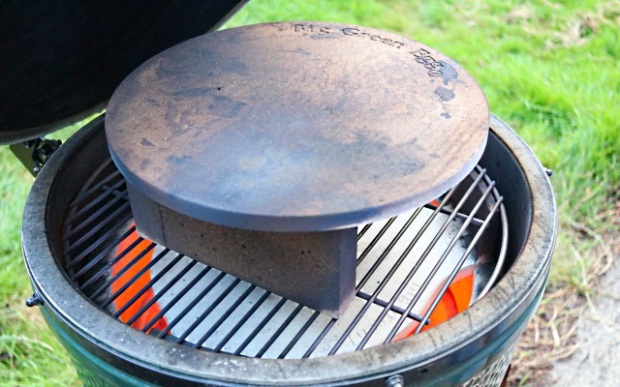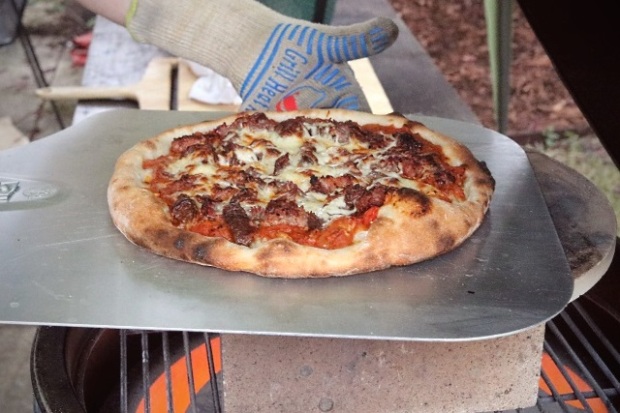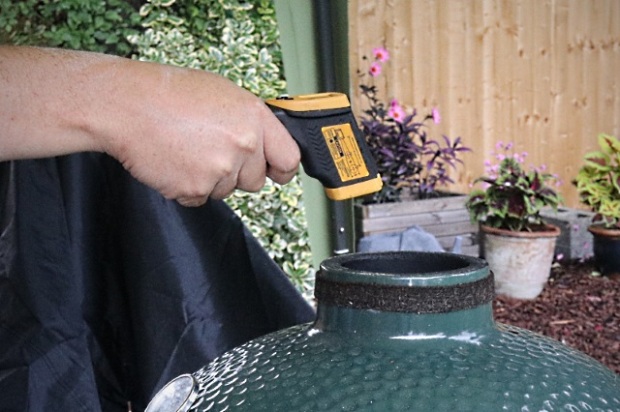Scratch-made pizza was a “road to Damascus” home-cooking moment. My oven-baked pizzas were really good. Yet whilst being tasty, and much better than pre-packaged products, they lacked that authentic pizzeria quality.
To go further in my pizza-making journey, I decided that I needed a proper pizza oven. My wife agreed. Seriously, she did … and she also discovered the Big Green Egg.
Welcome! Thanks for stopping by! Down below you’ll find out how I cook pizza in a Big Green Egg, it works for other ceramic cookers. There’s plenty more great info, feel free to browse around whilst you’re here. The most popular technique and pizza posts are:
- Cleaning your ceramic cooker
- Maxing out the Minimax / two level cooking
- Smoke your own cheese at home
- Long fermentation pizza dough … you gotta try this
- Moroccan lamb, goat’s cheese and spinach pizza
If you’d like to stay up to date with new blog posts, just click the Follow button on the right (or down the bottom for mobile device users). Now, on with cooking pizza in the Big Green Egg …
Big Green Egg Pizza Set-up
My set-up for pizza is platesetter legs up, standard grid and two fire bricks (not house bricks, they will shatter and damage the BGE). The fire bricks are placed on top of the grid vertically. This raises the pizza stone up into the dome so that heat radiating down from the ceramic lid cooks the toppings at the same rate as the base.

A thick crust pizza can also be cooked using the vertical brick set-up, it depends on the thickness and toppings. If unsure, cook with the bricks flat and see how it turns out, then adapt as necessary. Deep pan pizzas do not need fire bricks, and the pan can be placed directly on the grid.
Using fire bricks for thin crust pizza made a big difference to both quality and consistency. In addition, the pizzas had that lovely slightly burnt edge pizzeria look. The fire bricks that I use are 114mm high. The platesetter needs to be sitting on the BGE fire ring, any higher and the thermometer may touch the pizza.

Get this set up when the coals have lit, so that as the Egg comes up to temperature the stone warms as well. Continue to warm the stone for 20-30 minutes after the Egg has got to the desired temperature (see next section) before baking the pizza. I check that the pizza stone is ready by using a handheld instant read temperature gun.

Cooking Temperature and Time
This depends on the crust and/or amount of toppings.
- Thin crust: 375-400°C/710-750°F, cook for 4-5 minutes.
- Thick crust: 325-350°C/620-660°F, cook for 6-8 minutes.
- Deep-pan: 190°C/375°F, cook for 20-25 minutes. This is more like baking a pie, and the pizza stone does not need to be raised on fire bricks.
Whilst 400°C may seem excessive, consider that an authentic Neapolitan pizza is cooked at 485°C for 60-90 seconds. The above temperatures are guides, and are partly dependent on the dough being used. After a few cooks you’ll find your sweet spot.
To get the Egg to a high temperature, ensure that the firebox is full of charcoal and possibly even going into the fire ring. This will mean more pieces generating heat, but also less air space to heat up. Doing this will cause the Egg to get to a higher temperature, and relatively quickly. In addition, remove the daisy wheel completely and control the temperature with the bottom grate.
For your first time cooking pizza on a Egg, I recommend going with thin crust and cooking at 300°C/570°F for 7-9 minutes (or thick crust at 260°C/500°F for 8-10 minutes). It’s easy to cook an underdone pizza for a few more minutes, but impossible to go back in time and fix a burnt pizza cooked at too high a temperature. Once you get the hang of it, experiment with crust, toppings, temperature and time.
Getting the Pizza Onto The Stone
For cooking up to 300°C/570°F, you can use baking parchment to transfer the pizza to the stone. Higher temperatures require a tool such as a pizza peel, preferably a wooden one. I use a Superpeel to deploy the pizza into the Egg.
The pizza will probably need to be rotated during cooking to ensure an even cook, for this I use a steel pizza peel.
Using Cornmeal/Polenta … Or Not
The picture below shows cornmeal on the pizza stone. Burnt cornmeal. I used to think that using cornmeal was essential to safely getting the pizza off the stone. However, this isn’t the case. Pizza dough won’t stick to a hot (i.e. pre-heated) pizza stone. So I just ended up with burnt cornmeal and a slightly burnt base. I don’t use cornmeal for dusting the stone anymore.

High Temperature Cooking Safety Precautions
- High temperature cooking on a Egg must not be attempted until it has been used a few times at lower temperatures.
- The pizza stone must be able to handle the cooking temperature. If it can’t, it will shatter. I personally use the large Egg pizza stone.
- I use heat-resistant BBQ gloves when cooking pizza (pictured above). They can withstand the heat of a Egg running at such a high temperature.
- Always burp the Egg before opening fully.
And Lastly … Why Choose a Big Green Egg?
A Big Green Egg is well suited for baking authentic pizzas:
- It can get to high temperatures (400°C/750°F), which produces great thin crust pizza.
- The curved dome radiates heat down onto the toppings for an even cook.
- Smoke chips can be added for smoked-style pizzas.
Does it make that much difference? Yes, absolutely. In my experience there’s no contest, pizzas cooked in a BGE win every time. For the Ham and Mushroom pizza article, I used our oven. My wife said “It’s good, and it also shows how much better pizza tastes when cooked in our egg”.
